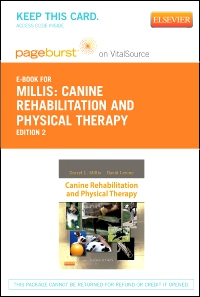
Canine Rehabilitation and Physical Therapy - Elsevier eBook on VitalSource, 2nd Edition
Elsevier eBook on VitalSource

Bridging the gap between human physical therapy and veterinary medicine, Canine Rehabilitation and Physical Therapy, 2nd Edition provides veterinary students with traditional and alternative physical therapy methods to effectively evaluate and treat dogs with various debilitating conditions. Coverage includes treatment protocols for many types of cutaneous, neurologic, and musculoskeletal injuries to facilitate a faster and more complete recovery.
-
- Invaluable protocols for conservative and postoperative treatment ensure the successful healing of dogs and their return to full mobility.
- NEW! Companion website with 40 narrated video clips of modalities and exercises used by physical therapists demonstrates effective ways to treat various neurologic and musculoskeletal problems in dogs.
- NEW! Fourteen new chapters describe the latest advances in the areas of joint mobilization, rehabilitation of the athletic patient, biomechanics of rehabilitation, therapeutic lasers, and physical therapy for wound care.
- Printable medical record forms on the companion website, including client information worksheets, referral forms, orthopedic evaluation forms, and more, can be customized for your veterinary practice.
- Six completely updated chapters on exercising dogs define the basic principles of aquatic and land-based exercise and how they may be applied to dogs, as well as how physical therapy professionals can adapt common "human" exercises to dogs.
- Numerous chapters on therapeutic modalities, including therapeutic lasers, illustrate how physical therapy professionals can adapt common "human" modalities to dogs.
- Physical examination chapters offer comprehensive information on orthopedics, neurology, and rehabilitation.
-
- New chapters keep you up to date with coverage of joint mobilization, rehabilitation of the athletic patient, biomechanics of rehabilitation, and physical therapy for wound care.
- A companion website includes 40 narrated video clips of various modalities and exercises used to correct problems with lameness, hip disorders, and gait analysis, plus downloadable and printable orthopedic, neurologic, and physical rehabilitation forms, in addition to a client information worksheet, referral form and letter, and a daily flowsheet form.
-
Section I: Introduction to Physical Rehabilitation
- History of Canine Physical Rehabilitation
- Regulatory and Practice Issues for the Veterinary and Physical Therapy Professions
- Conceptual Overview of Physical Therapy, Veterinary Medicine, and Canine Rehabilitation
- Canine Behavior
- Canine Anatomy
- Tissue Healing: Tendons, Ligaments, Bone, Muscles, and Cartilage
- Responses of Musculoskeletal Tissues to Disuse and Remobilization
- Exercise Physiology
- Exercise Physiology of the Canine Athlete – NEW!
- Orthopedic and Neurologic Examination
- Canine Locomotion Analysis
- The Physical Rehabilitation Evaluation – NEW!
- Assessing and Measuring Outcomes
- Rehabilitating the Painful Patient: Pain Management in Physical Rehabilitation – NEW!
- The Role of Chondroprotectants, Nutraceuticals, and Nutrition in Rehabilitation Nursing Care of the Rehabilitation Patient – NEW!
- Nursing Care of the Rehabilitation Patient – NEW!
- Devices for Ambulation Assistance in Companion Animals – NEW!
- Superficial Thermal Modalities
- Therapeutic Ultrasound
- Electrical Stimulation – NEW!
- Therapeutic Lasers in Canine Rehabilitation – NEW!
- Applications of Extracorporeal Shock Wave in Small Animal Practice – NEW!
- Other Modalities in Veterinary Rehabilitation – NEW!
- Biomechanics of Physical Rehabilitation and Kinematics of Exercise – NEW!
- Range-of-Motion and Stretching Exercises
- Joint Mobilization – NEW!
- Massage
- Exercises for Proprioception, Balance, and Joint Position Awareness
- Therapeutic Exercises: Early Limb Use Exercises
- Therapeutic Exercises: Joint Motion, Strengthening, Endurance and Speed Exercises
- Aquatic Therapy
- Common Orthopedic Conditions and Their Physical Rehabilitation
- Common Conditions and Physical Rehabilitation of the Athletic Patient – NEW!
- Neurologic Conditions and Physical Rehabilitation of the Neurologic Patient
- Physical Rehabilitation for Geriatric and Arthritic Patients
- Physical Therapy for Wound Care – NEW!
- Physical Rehabilitation for the Critically Injured Veterinary Patient
- Development of a Rehabilitation Facility for Small Animals and Business Considerations
Section II: Basic Science of Veterinary Rehabilitation
Section III: Patient Assessment and Management
Section IV: Therapeutic Modalities
Section V: Therapeutic Exercise and Manual Therapy
Section VI: Physical Therapy for Specific Diagnoses
Appendix 1: Protocol Development and Protocols
Appendix 2: Manufacturers of Supplies and Equipment – NEW!
Glossary
Index

 as described in our
as described in our 